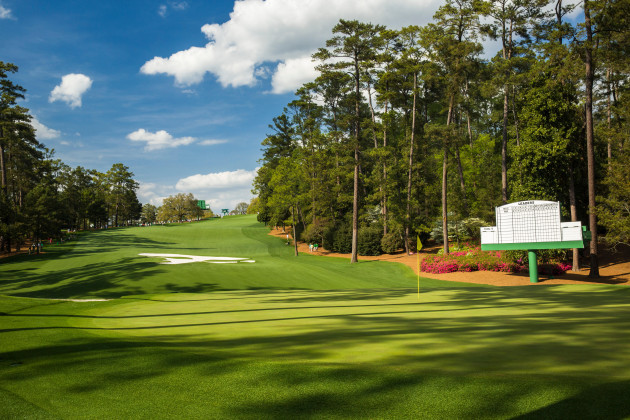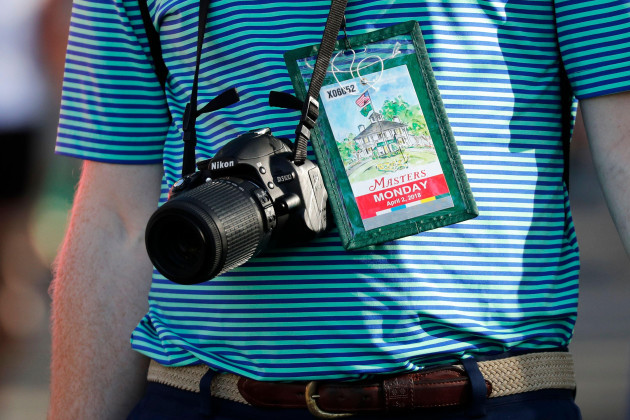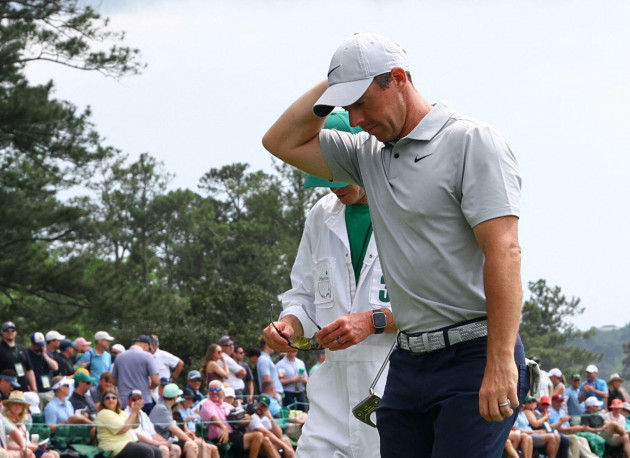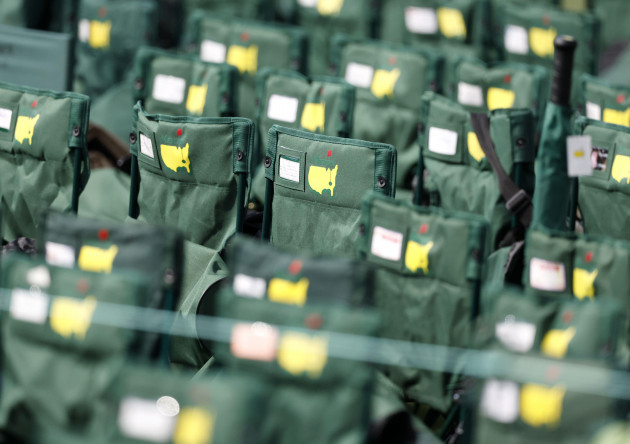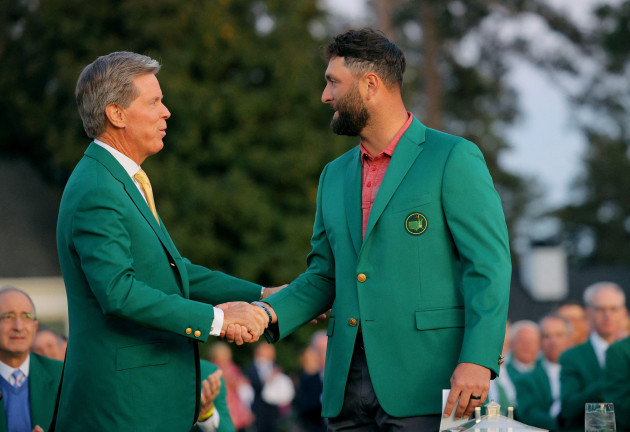As we close the book on the sporting year and get ready for another massive one, we’re looking back on some of our favourite pieces of sportswriting published on The 42 in 2023.
Today: having spent a week at the 2023 Masters and Augusta National, Gavin Cooney answers the question — ‘What’s it like?’
If you enjoy this piece, and would like unlimited access to all of our news, analysis, podcasts and sportswriting in 2024, you can sign up today at the42.ie/subscribe.
***
IT’S WEDNESDAY AFTERNOON of Masters week at Augusta, when tension is postponed for the family-oriented, unserious par-three contest.
A couple of miles away, the Bon Air sits crouched atop a hill, looming across the affluent suburbs of Walton Way as it does every day; the cloistered foyer jutting out like a tongue from its squat, imposing face.
Grand, cursive writing of ‘Bon Air’ still remains on a plaque outside that reads ‘The Bon Air Apartments’, with a smaller logo reading ‘equal housing opportunity’ tucked underneath. A few bare patches of grass and its scrubbed white facade hint at a new status.
In the old hotel foyer, a couple of trestle tables lie abandoned in the wings either side of the entrance. A printed sign regretfully announces that all the washing machines are currently out of order but will be fixed as soon as possible. Plaster peels off the corners of the walls, and the carpets are stained; stains fringed by a deep and ugly brown.
Before this was the Bon Air it was the Bon Air Vanderbilt and the most important hotel in Augusta: the quarters of the powerful and wealthy passing through in the first decades of the twentieth century, built as a symbol of recovery after the Civil War. Presidents Taft, Coolidge and Eisenhower all stayed there, as did one of the authors of the coming American age of self-invention, F. Scott Fitzgerald.
And it was in the ballroom of the Bon Air where Clifford Roberts brought together the first prospective members of a golf club to play a nearby course designed by Bobby Jones. Thus Augusta National Golf Club was officially born, along with their annual golf tournament. Bobby Jones, ever the Southern gentlemen, didn’t like Roberts’ title, believing it too immodest. Jones lost the argument and the Bon Air became the unofficial headquarters of the Masters. It was at the Bon Air Vanderbilt where the golfers stayed, and where the members, journalists and guests placed their bets and drank their winnings.
They don’t stay there anymore. The Bon Air did not rise to meet the dawn of the American century, sinking slowly after it was cut adrift from the Vanderbilt chain. Roberts grew so alarmed that Augusta National decided to build residences for their guests on the grounds of the golf course, and soon the Bon Air rose over Augusta as a beacon of faded, Southern elegance. It is no longer in the business of making money from the kindness of strangers: it’s no longer a hotel, and has been reopened to provide government-subsided housing.
A local news channel spoke with residents here earlier this year, who complained of roaches, rats, mould and damp. One elderly woman said her family won’t visit her here: she has to go to them. The building was bought by Redwood Housing last year for more than $15 million, and they say they want to be “part of the solution”, but that it would take time to address the profound disrepair they inherited.
The founding seat of the Masters is now an emblem of entropy and everything the Masters is not.
**********
“A tradition like no other” reads the Masters’ slogan, written in a curlicued font not dissimilar to the Bon Air’s.
At Augusta National Golf Club, obsessive maintenance is the guiding principle. The greens, for instance are cut to one-eighth of an inch, and the fairways to three-eighths of an inch.
This is a club and competition at which traditions, customs, and quiddities are not just revered, but enforced. Sedimentary layers of tradition that gives the Masters and the club its significance, and it is the significance of exclusivity. Few golfers will ever turn off Washington Road to drive down Magnolia Lane, and fewer still will have the luxury of picking out a shirt that won’t clash with the green jacket they have to wear at the Champions Dinner every Tuesday night of tournament week.
Each year, the reigning champion picks the menu and acts as host, and at the end of the meal, he is presented with a gold locket as a symbol of his initiation to sport’s most exclusive club.
Many of the Masters’ traditions enforce a hierarchy and among the most bizarre is the custom of flag-signing. Fans are allowed to seek autographs only in a specific area of the club during practice days of the club, and most collect signatures on a yellow, Masters-branded flag, mimicking those hanging on the 18 pins around the course. Each flag sold in the club shop has the year of that year’s Masters tournament above the tournament logo, which is a map of the United States on which a pin and hole marks Augusta in the south.
When signing autographs, only past champions are permitted to scribble their names within the borders of the US in the middle of the flag, with mere competitors forced to write their names by the edges. But there is even a hierarchy within this hierarchy. Ben Crenshaw says he hasn’t achieved enough to sign in the middle of the flag, so leaves that spot for the likes of Tiger Woods, Jack Nicklaus, or Gary Player.
But standing above all is Augusta National Golf Club. This is their event, and everyone is here on their say-so.
During the afternoon practice rounds on Tuesday, a patron (there are no fans or supporters around here – they are referred to as patrons) close to the 13th shouted out to a friend 30 feet away at a concession stand. An official standing inside the ropes shot an accusatory glare and said, “Hey, we don’t need that”, saying more quietly to me that it would have been a much sterner talking to had it been a tournament day.
The patron wouldn’t have been instantly ejected, the official told me, but instead warned and reminded “that badge is ours, not yours”, in reference to his ticket.
There is a firm expectation of good behaviour from everyone. The second page of the spectator guide reprints Bobby Jones’ code of conduct, which states that “in golf, customs of etiquette and decorum are just as important as rules governing play.” In other words, everyone is expected to act like the gentleman Bobby Jones was.
There’s also a strict ‘no running’ policy around the golf course, so if you break into anything above a brisk walk, you’ll be politely reminded, “Walk, please.” Nothing, however, is policed more strictly than the ban on mobile phones.
Nobody is allowed a mobile phone on the course. When I first asked colleagues if they had any advice for me ahead of my first trip to the Masters, everyone’s face darkened and said, “Make sure you don’t have your phone”, in a tone that suggested being caught with it could result in a punishment ranging from ejection to death to, worse, no invitation back next year. (There is simply no way of trying to get away with it: there were 1300 security personnel on the ground at the 2023 Masters, with many more in unmarked clothes.)
We were allowed our phones in the press building by the course, but it had to stay there. This was initially disorienting for the Very Online (a lamentable crew that includes your correspondent), caught as I was walking around outside without an effective appendage. Every so often I tapped my pockets in a brief panic as my phone’s absence twitched like a phantom limb. The genius of this policy dawns after a while. This may have been a singular experience , but with space to walk came space to think. I wasn’t hacking at my thoughts and impressions to reduce them to quippy, 140-character observations that might pop on Twitter, a state to which I’ve pathetically devolved.
Plus, without a phone to pointlessly record moments already being captured by professional operators using extremely expensive cameras, everyone around the course was so much more engaged with whatever was happening in front of them. Flowing from that is an atmosphere of deep satisfaction. And against a backdrop like Augusta National, how could it be otherwise?
The course is irresistibly beautiful: the many slopes and hills of the course offer perfect fragments of beauty wherever you end up. This is the good walk that can’t be spoiled: the arc around Amen Corner is the stuff of a tourist attraction. (If you want to snap a photo of it, you have to come during the three practice days from Monday to Wednesday, when cameras are permitted. They are forbidden during the tournament.)
At Augusta National, first you’re rapt and then you’re enraptured. There are no phones and no advertising on the course, while all of the scoreboards are manually operated and there are no clocks on display, either. Nor is there anything to suggest what year it is, bar perhaps a TV camera inside the ropes and the visa machines at the concession counters.
Life on the course at the Masters is a cultivated state of timeless bliss: the friendly y’alls, the cigar smoke that chokes the fragrant pines, the languor of the atmosphere, the lozenged, drawling accents, the white cabins… you could easily be standing in a scene from the 1800s and back in the South’s headier days, in an era before the more brusque, urban aspirations of the self-made man of the North became the dominant American story. If the self-made man could subvert and escape his surroundings, the archetype of the Southern Gentleman relied on a solid, unchanging context of established hierarchy, order, and custom.
The Masters and Augusta National feels like a seductive curation of precisely that scene. How can there be any sense of a decline over time when time itself is suspended?
**********
This sense of familiarity makes the Masters such compelling sport. The course is a protagonist in every golf tournament, but because the Masters is the only major to return to the same venue every year, Augusta National is the character everyone knows best.
The annual return to Augusta National also builds tradition in the purest, sporting sense. Stand at any hole and you can neatly overlay your view with the most famous footage from the past. Walk by the 10th hole and you’ll see patrons in the trees by the fairway, mimicking a swing with a baffled look wondering how, exactly, Bubba Watson found the green in the 2012 play-off.
Accumulated memory scores the competition. The weekend sound from the grandstand behind the par-three 12th is distinct. As the players move from the 11th green toward the tee, there is a slight hush, as if everyone is forcibly dampening their own instincts for disaster. It was here that Jordan Spieth twice found the water in 2016 to blow his chance of defending his title.
Players have to battle their own familiarities, too. The Masters crouches somewhere at the back of Rory McIlroy’s mind every day of the year and every April he has to fight against its taking over entirely. McIlroy is one Masters win away from winning the Grand Slam in golf, which would make him only the sixth man to do so in the history of the sport. His precocity and rare talent has put him in a very curious place of being expected to achieve something truly extraordinary. McIlroy has been coming to Augusta to complete the set since 2015, and it’s his great misfortune that he has left the Masters to the end as it has turned his greatest ambition into everyone else’s pilgrimage.
McIlroy sat graciously with the press for the usual catechisms on Tuesday morning, insisting that nobody wanted him to win the Masters more than he did, and that his final-round 64 at last year’s edition had “shed some scar tissue”. Alas, not enough. His even-par round on Thursday left him with some chasing to do on Friday morning and from there it went horribly awry. McIlroy stood on the seventh tee ashen-faced and demoralised, at three-over for the tournament and reckoning with being a failure around Augusta National once again, his belief that he was finally doing all the right things in preparation left smithereened. McIlroy inexplicably missed the cut, shooting a five-over 77 to leave with nothing but a fresh cauterisation that will have to be faced down next year. Hell isn’t meant to be this picturesque.
Tiger Woods did make the cut and so was sentenced to a risible, painful limp around the slick slopes on Saturday afternoon as the rain hammered down. He withdrew with injury on Sunday morning, having aggravated his salvaged right leg. Woods’s ghost will at least walk more comfortably around the place: this was the year to suggest that day is coming soon.
********
But for all its reverence for tradition and seeming ability to suspend time itself, the Masters and Augusta National has changed over the years. Radically.
Estimates say the site is 75% larger today than it was when Jones, Roberts and co. first came together in the Bon Air Vanderbilt, and every edition of the tournament features talk about some tweak or another.
Club chairman Fred Ridley admitted at his Wednesday press conference that they want to see “distance addressed”, by which is meant limiting how far the top players can now bomb the ball off the tee. With the sport still fulminating over modifying the golf ball to limit the distance, Augusta National got on with solving the problem as only they can: they bought a patch of land off a neighbouring golf course to lengthen the 13th hole by 35 yards.
That the club wants to see “distance addressed” is a rare instance of Augusta National openly bridling against modernity. It usually quietly accommodates the modern world to its own ends. Yes, they don’t allow phones on the course, but they have developed sport’s most magnificent app, the technology of which the producer of the Netflix show Full Swing described as the second-best streaming platform in the world after Netflix. But unlike Netflix, the Masters app is used four days a year. The arena in the media centre, meanwhile, was used for an eSports competition on the Sunday before competition, serving as the launch for a new video game with EA Sports titled Road to the Masters.
There are other apparent contradictions. There is no advertising around the course and TV broadcasts are curtailed, yet the Masters is a kind of corporate Valhalla. IBM rent out a whole street of houses in Augusta to accommodate and entertain clients, while Mercedes took over a neighbourhood, parking a couple of brand-new cars outside the gates. You’ll also learn a lot about the kind of clientele flocking to the Masters by looking at the folding green chairs lined around the greens. These are sold on-site for $35 and patrons leave them where they want, as a pouch on the back allows patrons to display their name and reserve their chair. Some write their names here, but more slot in their business cards. (If you need a lawyer at short notice at the Masters, there’s no need to go looking for the Yellow Pages.)
The Masters is also one of the biggest shopping events of the year. Their merchandise isn’t sold online or anywhere else, so the only way to get it is by attending the tournament. And with no selfies to be taken on the course, buying some branded gear is just about the only way of proving that you were there.
I joined the queue outside the club shop at noon on Monday: it stretched for a quarter-mile, snaking around the outside of the building like Rae’s Creek through Amen Corner. It was a 45-minute wait but that wasn’t for the want of flow of patrons into the building. The shop is estimated to turn over $277 a second during Masters week, with the gear not cheap but not as unreasonable as it might have been: a golf t-shirt cost $89. (Plus, further to the sense that the Masters is operating on its own timeline: their shop is the only place I’ve seen April to April calendars for sale.) The relatively fair pricing is reflected everywhere else. A sandwich will cost you $1.50, and you’ll get a beer for $5. Charging anything more might be deemed as ungentlemanly.
The difficulty is getting inside the gates to collect your change. There is an annual lottery for tickets and if you get lucky, you’ll only pay $100 for a ticket to a practice day and $140 for a tournament day. There are tournament-long badges available for only $350, the only slight problem being the waiting list is so backed up that it hasn’t even opened for more than 20 years. Tickets are available on third-party sites, but if you want to buy a ticket to the Monday practice day next year, it will currently set you back €1,200.
If you’re really desperate to get to the tournament, then you could enrol yourself in the Golf Tourism class in the University of South Carolina, which forms and informs the next generation of country club managers across America. Each year, approximately 600 students from this class are selected for a paid week’s work in hospitality at the Masters.
Or, if you don’t fancy doing any hard work, you could go as a member of the press. The media facilities at Augusta National have no other parallel in sports. Where other major events in golf have media tents, the Masters has an opulent, walnut-walled building that might have been a mansion in Gone with the Wind.
Security guards stand by the doors to open them for arriving journalists, with a central staircase leading to the arena, a giant room overlooking the practice driving range in which journalists are each given an assigned desk, marked with a brass name plate. (The tournament this year forbade journalists from publishing pictures of their workstation, saving the world an avalanche of smug, ‘my office for the week’, tweets.) There are constant shuttle buggy services running to the course, but everything else is laid on to convince you that there is no real need ever to leave the building. That includes food and drink: it’s all free. The governing policy is less treat ‘em mean, keep ‘em keen than it is, treat ‘em much better than they are treated anywhere else, keep ‘em grateful.
In exchange for it all, no journalist can miss Cliff Roberts’ words displayed by the entrance to the arena. It’s an old quote that ends on a note of contemporary resonance.
The Masters Tournament has been favoured with unusually good relations with all segments of the news fraternity. This was true at the beginning and I am confident that it exists today.
**********
Augusta National was hardly of Augusta from the moment of its foundation, . The vast majority of its first membership travelled down to the Bon Air by train from New York, and were a city coterie of the wealthy and powerful, handpicked by Clifford Roberts.
As for the relationship between golf club and city nowadays: it’s mixed and complex.
The members of Augusta National carry around a green card in their green jackets, on which is written the club’s mission statement. One of its underlying principles, said Chairman Fred Ridley, reads “we are committed to our community”. Ridley delivered his annual State of the Masters address on Wednesday, at which he cited that commitment to community in announcing a new partnership which will see Augusta National fund the renovation of a municipal golf course in Augusta known as The Patch. Nobody felt it necessary to ask whether this community commitment would ever extend to the point that the public might one day be invited to play Augusta National.
Some locals I spoke to weren’t quite sure when the Masters started, and the tournament exists to them as the week of sudden traffic jams on Washington Road, quite baffled as to why people fly from as far as Ireland to see a place like Augusta. (When I asked one local what they would recommend I see around Augusta and away from the golf course, she suggested a Dave& Buster’s arcade bar.) Others are unmistakably proud of it, and a Masters flag is hung by the American flag on their porch for tournament week.
But it is largely a transactional relationship. Not every town in America is bestowed with an influx of wealth like Masters week, so everyone gets into the business of making hay. $50 motels are jacked up to $500 a night, while locals clear out and rent out their houses to players, journalists, and patrons. Dwight Eisenhower is probably Augusta National’s most famous member: his way of giving back to the town was an introduction of a tax break to the locals so that any Augusta residents can rent out their home for up to 14 days every year and not pay any tax on the income. Spring Break has been moved to coincide with Masters week with the added bonus of the following Monday off too, allowing all visitors time to pack up and fly home.
The Bon Air is not a solely benign signifier of Augusta’s past. In the early decades of the 1900s, the hotel, like many others in the city, staged the wretched spectacle of the battle royal, where young Black boys were blindfolded, thrown into a boxing ring, and told to start swinging as the white men in the audience bet on who would be the last man standing. The earliest members of Augusta National indulged in the barbarism in the Bon Air’s ballroom, and James Brown, the Godfather of Soul, was among the boys forced to fight.
The demeaning spectacles were ultimately left behind by the times; times against which Augusta National continued to move glacially. The club’s first Black member wasn’t inducted until 1990, while it wasn’t until 2012 that Condoleezza Rice and Darla Moore were announced as the club’s first female members. There is little information out there about the membership, and the club is committed to privacy. They have not registered as a non-profit organisation, so they are under no obligation to divulge information about their members or about the scale of their reserves.
But this year, that secrecy was placed under threat. As part of an antitrust lawsuit against the PGA Tour, the Saudi Arabia-backed breakaway LIV golf tour applied for the subpoenaing of correspondence between named persons and all members of Augusta National on the subject of any breakaway tour. LIV’s application was ultimately denied, but the antitrust litigation continues.
LIV are self-identifying disruptors, and the presence of 18 of their golfers at the Masters provided the first opportunity this year to assess the depths of the sport’s rifts and ruptures in surroundings ordinarily insisting on uniformity and strict etiquette.
Perhaps unsurprisingly, everyone fell into line with the wishes of Augusta National and played sweet. The LIV players shied away from any opportunities to criticise their PGA Tour colleagues, with Phil Mickelson repeatedly stressing how grateful he was for the opportunity to play at the Masters. LIV had six representatives around the table at the Champion’s Dinner, with Ridley noting afterwards that the tone was “really good”.
“I would not have known that anything was going on in the world of professional golf other than the norm,” he added. “So I think, and I’m hopeful, that this week might get people thinking in a little bit different direction and things will change.”
On the subject of another Norm: Greg Norman, LIV’s CEO and agitator-in-chief was not invited, with Ridley saying he wanted to keep the focus on the competition before adding haughtily, “in the last ten years, Greg Norman has only been here twice, and I believe one of those was as a commentator for Sirius Radio.”
LIV didn’t add another green jacket to their burgeoning number of suits, with Jon Rahm overhauling Brooks Koepka on the final day to win by four shots. That Koepka faded after 54 holes is a rich irony, but he did tie for second place with his fellow LIV pro Mickelson, while their colleague Patrick Reed finished in a tie for fourth place. The runners-up have their names engraved on the giant Masters trophy that resides permanently in the clubhouse, so this was virtually the only way in which the LIV guys left their mark.
A bombastic breakaway revelling in its lack of tradition and history, the LIV Tour is everything the Masters and Augusta National is not. But this week LIV’s CEO watched on TV as his players competed for the green jacket and said thanks very much for the opportunity to do so. Koepka didn’t even follow his bosses’ expectation to wear his LIV-branded gear. The Masters was the only show in town.
In their court filing earlier this year, LIV described the membership of Augusta National as being made up of “approximately 300 people, virtually all of whom are in rarefied positions of power and influence”, describing Augusta National as “a small club with a small membership comprised of America’s most powerful people that hosts the most important professional golf major.”
Beyond the endless curating of the traditions and etiquette and the horticulture, it is ultimately this status that is so obsessively maintained at the Masters.
The 2023 week went to show it’s safer than ever.


